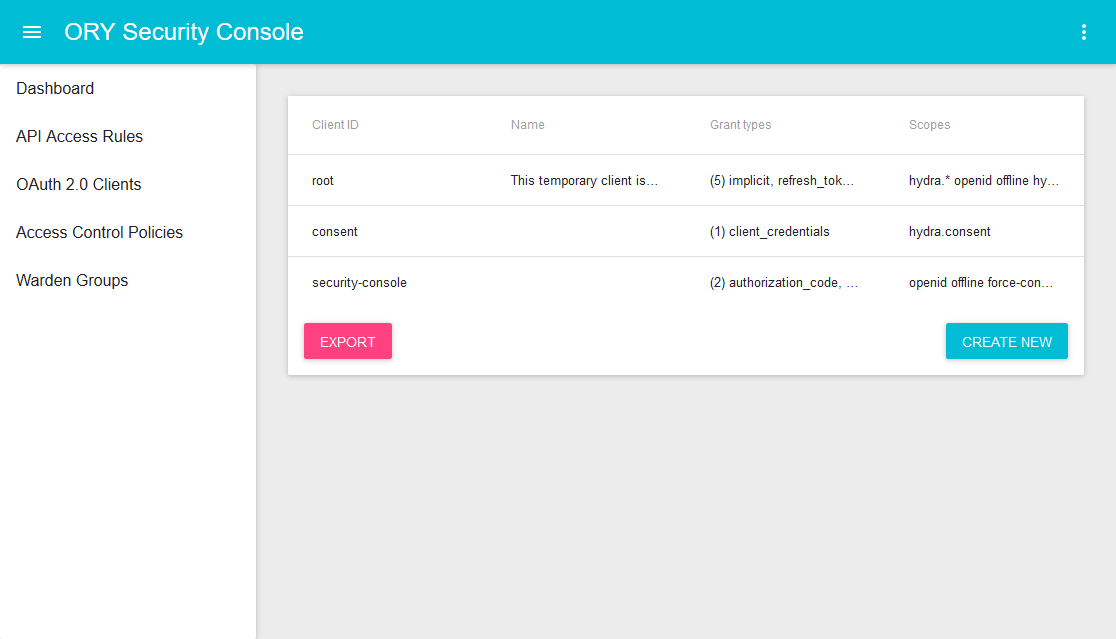ORY Hydra is a hardened, OpenID Certified OAuth 2.0 Server and OpenID Connect Provider optimized for low-latency, high throughput, and low resource consumption. ORY Hydra is not an identity provider (user sign up, user log in, password reset flow), but connects to your existing identity provider through a login and consent app. Implementing the login and consent app in a different language is easy, and exemplary consent apps (Go, Node) and SDKs are provided.
If you're looking to jump straight into it, go ahead:
- Run your own OAuth 2.0 Server - step by step guide: A in-depth look at setting up ORY Hydra and performing a variety of OAuth 2.0 Flows.
- ORY Hydra 5 Minute Tutorial: Set up and use ORY Hydra using Docker Compose in under 5 Minutes. Good for quickly hacking a Proof of Concept.
- (Install and Set Up ORY Hydra)[https://www.ory.sh/docs/hydra/configure-deploy]: An advanced look at installation options and interaction with ORY Hydra.
- (Integrating your Login and Consent UI with ORY Hydra)[https://www.ory.sh/docs/hydra/oauth2]: The go-to place if you wish to adopt ORY Hydra in your new or existing stack.
Besides mitigating various attack vectors, such as database compromisation and OAuth 2.0 weaknesses, ORY Hydra is also able to securely manage JSON Web Keys. Click here to read more about security.
Table of Contents
- What is ORY Hydra?
- Quickstart
- Ecosystem
- Security
- Benchmarks
- Telemetry
- Documentation
- Libraries and third-party projects
- Blog posts & articles
ORY Hydra is a server implementation of the OAuth 2.0 authorization framework and the OpenID Connect Core 1.0. Existing OAuth2 implementations usually ship as libraries or SDKs such as node-oauth2-server or fosite, or as fully featured identity solutions with user management and user interfaces, such as Dex.
Implementing and using OAuth2 without understanding the whole specification is challenging and prone to errors, even when SDKs are being used. The primary goal of ORY Hydra is to make OAuth 2.0 and OpenID Connect 1.0 better accessible.
ORY Hydra implements the flows described in OAuth2 and OpenID Connect 1.0 without forcing you to use a "Hydra User Management" or some template engine or a predefined front-end. Instead it relies on HTTP redirection and cryptographic methods to verify user consent allowing you to use ORY Hydra with any authentication endpoint, be it authboss, User Frosting or your proprietary Java authentication.
The ORY community stands on the shoulders of individuals, companies, and maintainers. We thank everyone involved - from submitting bug reports and feature requests, to contributing patches, to sponsoring our work. Our community is 1000+ strong and growing rapidly. The ORY stack protects 1.200.000.000+ API requests every month with over 15.000+ active service nodes. Our small but expert team would have never been able to achieve this without each and everyone of you.
The following list represents companies that have accompanied us along the way and that have made outstanding contributions to our ecosystem. If you think that your company deserves a spot here, reach out to hi@ory.sh now!
Please consider giving back by becoming a sponsor of our open source work on Patreon or Open Collective.
| Type | Name | Logo | Website |
|---|---|---|---|
| Sponsor | Raspberry PI Foundation | raspberrypi.org | |
| Contributor | Kyma Project | kyma-project.io | |
| Sponsor | ThoughtWorks | thoughtworks.com | |
| Sponsor | Tulip | tulip.com | |
| Sponsor | Cashdeck / All My Funds | cashdeck.com.au | |
| Sponsor | 3 Rein | 3rein.com (avaiable soon) | |
| Contributor | Hootsuite | hootsuite.com | |
| Adopter * | Segment | segment.com | |
| Adopter * | Arduino | arduino.cc |
We also want to thank all individual contributors
as well as all of our backers
and past & current supporters (in alphabetical order) on Patreon: Alexander Alimovs, Billy, Chancy Kennedy, Drozzy, Edwin Trejos, Howard Edidin, Ken Adler Oz Haven, Stefan Hans, TheCrealm.
* Uses one of ORY's major projects in production.
ORY Hydra implements Open Standards set by the IETF:
- The OAuth 2.0 Authorization Framework
- OAuth 2.0 Threat Model and Security Considerations
- OAuth 2.0 Token Revocation
- OAuth 2.0 Token Introspection
- OAuth 2.0 Dynamic Client Registration Protocol
- OAuth 2.0 Dynamic Client Registration Management Protocol
- OAuth 2.0 for Native Apps
- Proof Key for Code Exchange by OAuth Public Clients
and the OpenID Foundation:
- OpenID Connect Core 1.0
- OpenID Connect Discovery 1.0
- OpenID Connect Dynamic Client Registration 1.0
- OpenID Connect Front-Channel Logout 1.0
- OpenID Connect Back-Channel Logout 1.0
ORY Hydra is an OpenID Foundation certified OpenID Provider (OP).
The following OpenID profiles are certified:
- Basic OpenID Provider (response types
code) - Implicit OpenID Provider (response types
id_token,id_token+token) - Hybrid OpenID Provider (response types
code+id_token,code+id_token+token,code+token) - OpenID Provider Publishing Configuration Information
- Dynamic OpenID Provider
To obtain certification, we deployed the reference user login and consent app (unmodified) and ORY Hydra v1.0.0.
This section is a quickstart guide to working with ORY Hydra. In-depth docs are available as well:
The tutorial teaches you to set up ORY Hydra, a Postgres instance and an exemplary identity provider written in React using docker compose. It will take you about 5 minutes to complete the tutorial.
Head over to the ORY Developer Documentation to learn how to install ORY Hydra on Linux, macOS, Windows, and Docker and how to build ORY Hydra from source.

The ORY Security Console is a visual admin interface for managing ORY Hydra, ORY Oathkeeper, and ORY Keto.
ORY Oathkeeper is a BeyondCorp/Zero Trust Identity & Access Proxy (IAP) built on top of OAuth2 and ORY Hydra.
ORY Keto is a policy decision point. It uses a set of access control policies, similar to AWS IAM Policies, in order to determine whether a subject (user, application, service, car, ...) is authorized to perform a certain action on a resource.
The ory/examples repository contains numerous examples of setting up this project individually and together with other services from the ORY Ecosystem.
Why should I use ORY Hydra? It's not that hard to implement two OAuth2 endpoints and there are numerous SDKs out there!
OAuth2 and OAuth2 related specifications are over 400 written pages. Implementing OAuth2 is easy, getting it right is hard. ORY Hydra is trusted by companies all around the world, has a vibrant community and faces millions of requests in production each day. Of course, we also compiled a security guide with more details on cryptography and security concepts. Read the security guide now.
If you think you found a security vulnerability, please refrain from posting it publicly on the forums, the chat, or GitHub and send us an email to hi@ory.am instead.
Our continuous integration runs a collection of benchmarks against ORY Hydra. You can find the results here.
Our services collect summarized, anonymized data which can optionally be turned off. Click here to learn more.
The Guide is available here.
The HTTP API is documented here.
New releases might introduce breaking changes. To help you identify and incorporate those changes, we document these changes in UPGRADE.md and CHANGELOG.md.
Run hydra -h or hydra help.
Developing with ORY Hydra is as easy as:
go get -d -u github.com/ory/hydra
cd $GOPATH/src/github.com/ory/hydra
make init
export GO111MODULE=on
## With database
make test
## Without database
make quicktest
Then run it with in-memory database:
DSN=memory go run main.go serve all
Notes
- We changed organization name from
ory-amtoory. In order to keep backwards compatibility, we did not rename Go packages. - You can ignore warnings similar to
package github.com/ory/hydra/cmd/server: case-insensitive import collision: "github.com/sirupsen/logrus" and "github.com/sirupsen/logrus".
Official:
Community:
- Creating an oauth2 custom lamda authorizer for use with Amazons (AWS) API Gateway using Hydra
- Warning, ORY Hydra has changed almost everything since writing this article: Hydra: Run your own Identity and Access Management service in <5 Minutes


